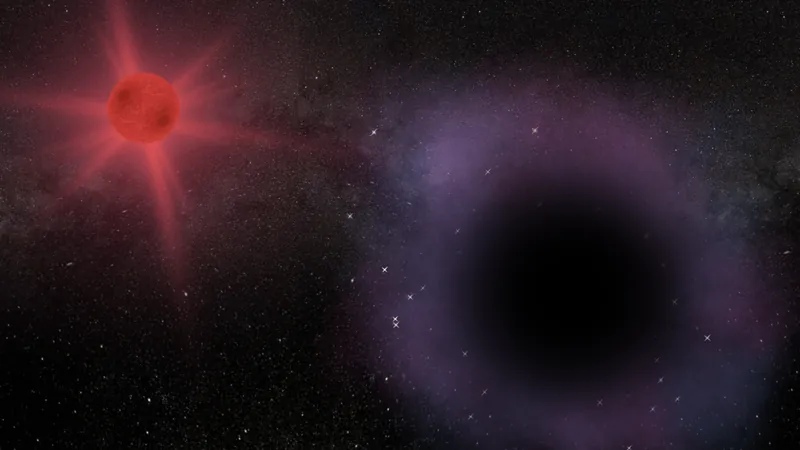
Uncovering a Stellar Mystery: 'Missing Link' Black Hole Found in Rare Binary System!
2024-09-24
Author: Jia
Astronomers Excited by Groundbreaking Discovery
Astronomers are buzzing with excitement after the discovery of a potential "missing link" black hole orbiting a red giant star in the binary system G3425, located approximately 5,800 light-years from Earth. This finding not only adds to our understanding of black holes but also challenges existing theories about their formation and behavior.
About the G3425 System
The G3425 system features a red giant star—a massive celestial body that has exhausted its hydrogen fuel and entered a phase where it can no longer sustain nuclear fusion in its core. As a result, its outer layers swell dramatically, expanding to nearly 100 times its original size. In the distant future, our own sun will undergo a similar transformation, evolving into a red giant and engulfing the inner planets, including Earth, within its expanded reach.
The Black Hole's Characteristics
However, G3425's red giant is accompanied by a remarkable dark companion: a black hole estimated to be between 3.1 and 4.4 solar masses, with a probable mass around 3.6 times that of our sun. This black hole resides within what is termed the "mass gap," a region of stellar-mass black holes that have remained elusive to astronomers. Team leader Wang Song from the National Astronomical Observatories of the Chinese Academy of Sciences emphasized the significance of this discovery, stating, "Not only does it confirm the existence of mass-gap black holes, but it also demonstrates that low-mass black holes can survive supernova explosions."
Evidence Gathering
The evidence of this newfound black hole was gathered from extensive data collected by the Large Sky Area Multi-Object Fiber Spectroscopic Telescope (LAMOST) and the Gaia space telescope, which tracks the positions of billions of stars across the Milky Way. By observing the gravitational influence of the black hole on its red giant companion, scientists were able to confirm its presence despite its invisible nature.
Understanding Black Hole Formation
Historically, black holes have presented considerable puzzles to astronomers. Defined primarily by their mass, they can be categorized into supermassive black holes, which can be millions to billions of times more massive than the sun, and intermediate-mass black holes, ranging from 100 to 100,000 times solar mass. Stellar mass black holes, the tiniest of the group, typically range from about 5 to 25 solar masses. However, the absence of black holes between 3 and 5 solar masses has confounded scientists, leading to critical questions regarding the processes that govern black hole formation.
Challenges to Conventional Theories
Some researchers propose that during the cataclysmic supernova events—explosions marking the death of massive stars—certain mechanisms might prevent the formation of these lighter black holes. Additionally, black holes that receive powerful "kicks" during supernovae are likely to be ejected into space rather than remaining in a binary system, thus making them difficult to detect.
Implications for Binary Evolution
The G3425 system challenges conventional theories, particularly with its wide circular orbit, which spans about 880 Earth days. This near-perfect circularity poses questions about how such a binary configuration could form, especially given the low mass of the black hole involved. Wang Song asserts, "The unique characteristics of this binary system present a significant challenge to our current models of binary evolution and the dynamics of supernova explosions."
Conclusion and Future Prospects
In summary, the discovery of this "missing link" black hole in G3425 not only enriches our understanding of black hole demographics but also prompts a reevaluation of existing astronomical theories. The implications of this find are vast, potentially reshaping the way we think about universal processes and the evolution of stars. As researchers continue to explore this intriguing system, the cosmos holds even more secrets yet to be unveiled. Stay tuned for further updates on this groundbreaking discovery!




 Brasil (PT)
Brasil (PT)
 Canada (EN)
Canada (EN)
 Chile (ES)
Chile (ES)
 Česko (CS)
Česko (CS)
 대한민국 (KO)
대한민국 (KO)
 España (ES)
España (ES)
 France (FR)
France (FR)
 Hong Kong (EN)
Hong Kong (EN)
 Italia (IT)
Italia (IT)
 日本 (JA)
日本 (JA)
 Magyarország (HU)
Magyarország (HU)
 Norge (NO)
Norge (NO)
 Polska (PL)
Polska (PL)
 Schweiz (DE)
Schweiz (DE)
 Singapore (EN)
Singapore (EN)
 Sverige (SV)
Sverige (SV)
 Suomi (FI)
Suomi (FI)
 Türkiye (TR)
Türkiye (TR)
 الإمارات العربية المتحدة (AR)
الإمارات العربية المتحدة (AR)